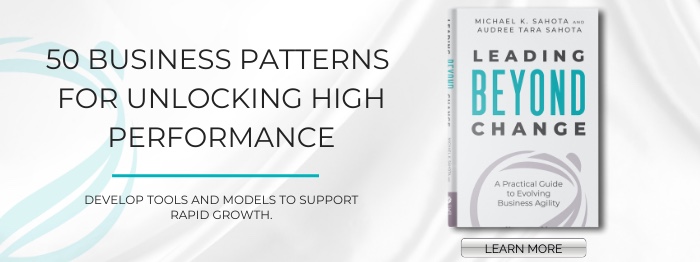In a conscious business, everyone is focused on the evolutionary purpose of the organization- everyone is contributing, egos are dissolved – people are working towards the common goal of creating products and services. They are contributing and collaborating with joy. There are fewer structures needed to control people to do the work, and the work is aligned with peoples’ life purpose – so it becomes a pleasure to create.
But how do you actually achieve that? When first attempting to create a conscious business, a lot of leaders approach it by creating a values program. “These are the four values that we’re going to live by.” This rarely works, for the simple reason that you can’t mandate conscious business practices – you can only support their emergence.
In this article, we’ll look at some of the blocks to conscious business as well as how to actually create a conscious business.
The Trap of Hierarchy
There is nothing wrong with hierarchy – it is the consciousness from which it is used that determines a hierarchy that can lead an organization successfully.

Many companies start their lives with direct personal relationships and no or limited hierarchy.
A lot of startups have a really amazing culture because there aren’t a lot of people. The management teams are managing the culture–they’re very open and inviting, management styles are not mandating and controlling. There is psychological safety and a lot of space for innovation, collaboration people are part of the process to create high performance and delivery.
As these organizations grow, structures are put in place because, for the managers and the executives, things start to get out of hand. When organizations grow and get bigger, people want control. Business practices from the past, business as usual, becomes the norm. What happens is that collaboration is taken out of the equation because people become fearful.

You can have collaboration when there are 20 people on a team or within the organization. When it starts getting bigger, what happens is that leaders become fearful and they feel the need to take greater control. Then there becomes the lack of equal voice, lack of psychological safety and command and control behavior. It’s not that people want to be oppressive–they simply don’t know how to function outside of command and control.
The consciousness of leaders needs to evolve to handle a larger organizational group. So the way to keep your business productive and conscious is to evolve the leadership.

You Ship Your Organization
Many leaders don’t realize that the environment in their workspace is going to impact their products and services. Let’s say you make a fizzy, bubbly drink, and everybody in the company is working in a command and control framework. Everything is mandated from top-down, nobody has equal voice, there’s a lack of psychological safety, and people are afraid of their jobs.
The consumer that is drinking your fizzy bubbly drink is also drinking your organization’s lack of psychological safety, workers’ fear of their jobs, and their disdain for their boss. They’re drinking whatever’s in the workplace.
Most leaders don’t even realize this is happening. They also don’t realize that the command and control environment takes away workers’ intelligence and their physical health, so there’s a lot of loss. Not only financial loss in the workplace, but loss of morale and enthusiasm. Employee engagement drops tremendously when you have environments that are set up like this.
Evolving Leadership Is the Key to Conscious Business
Most leaders operate in a low state of consciousness. What I mean by a low state of consciousness is that our thoughts, belief systems, and behaviors are coming from a state of unawareness, separation, and negativity. We’re not aware of our behaviors, and we’re certainly not aware of how they impact people around us.

Take some time to notice what state of consciousness you’re in. Most of the time you’ll notice that you’re in a state of frustration, anger, or sadness – or you’re completely distracted. That means you’re not being conscious of the impact that you have on your environment and the people around you.
Creating a conscious business begins with the leaders, for the simple reason that leaders model the culture for the rest of the organization. There are two aspects to operating as a conscious leader: Being and Doing. Being is about how you show up. Doing is about the practices, structures, and procedures you put in place.
Being
Creating a conscious business starts with each individual leader being in a conscious state. How are you treating people? How do you feel about the people that you work with? Let’s start there in a very simple place. Do you have healthy, trusting relationships? Do you see workers and peers as brillant, intelligent and capable of doing a great job? Do you try to push your agenda on other people? Or do you hold back what you want and are open to listening to the system and collaboration to get an outcome? Are aligned with the organizational purpose, not your own successes? These are just small pieces, but they are the foundation of operating in a conscious way.
Doing
The bigger picture for how to create a conscious business is looking at all of the practices, structures, and procedures that you have in place as an organization. Are you looking at how people are being treated? Is the environment set up for psychological safety? Are meetings run in such a way that everybody has a voice? Are you mandating your processes and procedures or a values program?

How to Get Started Now
Creating a conscious business is essential, yet – to those operating in the traditional framework – it may seem impossible. However, there are some simple steps you can take today to begin creating a conscious business.
Pause
You can notice how you’re showing up as a leader, pause for a moment, and choose a different way to lead. Using this simple practice, those who have taken our training behave differently even in difficult situations.
For example when they’re in these leadership situations where they’re being mandated that their team delivers a project, they don’t function with a top-down mandate. They take that moment to breathe and they choose something very different. They might go to their team and say, “Hey, team. How can we deliver this project under budget and on time? How can we collaborate together to figure this out?”
The leadership style becomes very different. You know the impact that it’s going to have on your people and you know that when they’re in a negative situation the output is going to be less. You understand as a leader that when people have psychological safety, they’re engaged and motivated, they’re going to deliver high performance. When you have the ability as a leader to create other leaders around you, you’re able to bring out the brilliance in others and you can solve problems together.

Use a People-Centric Approach
One of the first steps to creating a conscious business is to use a people-centric approach. Creating an environment where people feel psychologically safe and are really listened to is the basis of a conscious business. If employees feel they have equal voice, people will feel respected and engagement will go up.
Look at employee engagement. The conventional wisdom of taking care of customers first has been replaced with an employees-first framework. Happy employees will take care of your customers, and when your customers are taken care of, the money’s coming in and stakeholders are taken care of. So really it’s your employees who are the heart of your organization and when they’re treated well, then the whole entire organization performs well.
Recreate Structures
We often say that a new way of being enables a new way of working. To create a conscious business you really have to show up in a conscious way, and what that means is becoming aware of the impact that you have. So in macro and micro we can go in and out, but really it’s starting with leadership and how have you organized your organization? How have you structured your organization and its business practices? How do you handle your finances? How do you handle project management? How do you handle your HR? How are the people interacting within your organization? How is the environment set up?

You can also look at your HR structures. Simple things like vacation days, sick days, and days off can all be organized so that people’s personal lives are just as important as their work lives.
The big trap is to change structures without shifting the consciousness of leadership. Many organizations try to create so-called Teal organizations without an evolution of leadership first. Evolving structures only works to the extent that the leadership has evolved.
Leadership Training for Conscious Business
Leaders working in a framework of command and control are very careful about mandating practices and having constraints on how people are working. A lot of people are now working from home, which has the opportunity to create more of an open work environment.
However, most leaders are not trained to lead in ways that are open, inviting, and people-centric, and so just flip back to the old ways of command and control because it’s what they know. Leaders need training in order to lead in a people-centric way.
SHIFT314 was created to develop conscious leaders – and with them, a world of conscious businesses. Our leadership training is for leaders who are ready to dive deep and learn practical tools for building conscious business.



